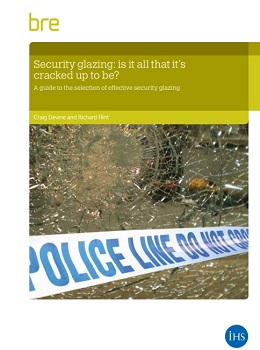Security glazing
In October 2016, BRE published the findings of a research project undertaken to investigate the performance and safety of glazing in security applications. The guide was primarily developed to help with the selection of effective security glazing.
The publication of ‘Security glazing: Is it all that it’s cracked up to be?’ (FB 55) followed a series of burglaries in London’s West End in 2008, ‘smash-and-grab’ attacks used to steal expensive goods from shop window displays.
The research explored the notion that, in some cases, glazing offered the least resistance to forced entry in situations where the generation of noise did not deter criminals. This premise was further demonstrated in the 2011 riots that hit major cities around the UK.
In addition to focusing on security, the research also examined an associated safety issue – that the majority of injuries from explosive events, including terrorist attack, invariably result from flying glass particles. Therefore, finding the correct specification of glazing to resist attack and reduce injury is vital.
The research uncovered a problem relating to the selection of an appropriate product to meet these dual requirements. A number of different glazing standards have been developed based upon specific test requirements. For example, glazing may be subject to a simulated manual attack or impacted by a known mass at a known velocity. However, the test results are not always directly comparable with those of tests conducted to other standards.
It is therefore useful to have an understanding of which standard is best suited to a particular application.
The types of glazing that the guide covers include:
- Acrylic.
- Fire-resistant glass.
- Float glass.
- Glass brick.
- Insulated glazing units.
- Laminated glass.
- Polycarbonate.
- Toughened glass.
- Wired glass.
The guide aims to assist architects, consultants, police officers and others who advise people on the selection of effective security. As well as focusing on physical security, particularly the resistance to manual attack of different glazing types, the guide also contains advice relating to other performance attributes.
You can download the guide from BRE Bookshop.
[edit] Related articles on Designing Buildings Wiki
- Annealing.
- BRE articles on Designing Buildings Wiki.
- Building fabric.
- CCTV.
- Electric lock.
- Embedded security: Procuring an effective facility protective security system.
- Fire detection and alarm systems.
- Glass.
- Glass block wall.
- Glass manifestation.
- Glazing.
- How to install an underfloor safe.
- Outbuildings security.
- Patent glazing.
- Perimeter security.
- Polycarbonate plastic.
- SABRE Security Assurance by the Building Research Establishment.
- Safety glass.
- Secondary glazing.
- Security and the built environment.
- Types and manufacture of laminated glass.
- Types of alarm.
- Types of lock.
Featured articles and news
Homes England creates largest housing-led site in the North
Successful, 34 hectare land acquisition with the residential allocation now completed.
Scottish apprenticeship training proposals
General support although better accountability and transparency is sought.
The history of building regulations
A story of belated action in response to crisis.
Moisture, fire safety and emerging trends in living walls
How wet is your wall?
Current policy explained and newly published consultation by the UK and Welsh Governments.
British architecture 1919–39. Book review.
Conservation of listed prefabs in Moseley.
Energy industry calls for urgent reform.
Heritage staff wellbeing at work survey.
A five minute introduction.
50th Golden anniversary ECA Edmundson apprentice award
Showcasing the very best electrotechnical and engineering services for half a century.
Welsh government consults on HRBs and reg changes
Seeking feedback on a new regulatory regime and a broad range of issues.
CIOB Client Guide (2nd edition) March 2025
Free download covering statutory dutyholder roles under the Building Safety Act and much more.
Minister quizzed, as responsibility transfers to MHCLG and BSR publishes new building control guidance.
UK environmental regulations reform 2025
Amid wider new approaches to ensure regulators and regulation support growth.
BSRIA Statutory Compliance Inspection Checklist
BG80/2025 now significantly updated to include requirements related to important changes in legislation.
























